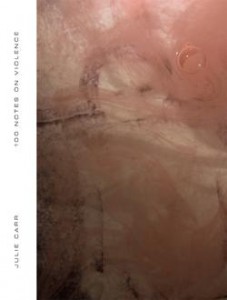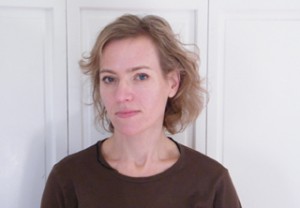 Book Title, Press, Year of Publication:
Book Title, Press, Year of Publication:
100 Notes on Violence, Ahsahta Press, 2010
Synopsis: A book, in 100 sections, about local and intimate violence.
What do you think makes your book (or any book) a “project book”?
Perhaps any book that the author wrote with some unifying theme or structure in mind is a project book.
Why this subject (or constraint)?
I was obsessed with the topic of violence as it was impacting my and my children’s lives. I wanted to confront it rather than run away from it. It was a spiritual mission.
In what ways was your project book designed or conceived before you started writing? And/or to what degree did the project develop organically as you added poems?
I began not with the theme, but with the structure. At first I simply wanted to write a long piece in 100 sections. At some point I began to realize that I needed to write about violence. Once that realization hit, it was a matter of just doing the work (which included a lot of reading, research, and talking with others) while staying open to various understandings of what the work might mean. I didn’t want to control it too much, but if a piece of writing seemed to have nothing to do with violence, I did not include it (unless as counterpoint). Still, part of the exploration was to consider that there was nothing outside of violence: no way to exactly escape suffering. Therefore, anything, really, could be included. I was learning from the writing, rather than pushing it.
What self-imposed rules or constraints shaped your book (and the poems in it)? Did you allow yourself to break them?
The only rule was to be brave. But I kept the violence local – I did not consider war or international violence very much. The reason for this was that I wanted the book stay close to home and to implicate myself, rather than others. I also did not look at child porn out of respect for my own boundaries.
How important was it for you that each poem could “stand on its own” or that the poems should rely on other poems in the book, or on the premise of the project itself, to succeed? What challenges did this present for you when writing single poems or structuring the book overall?
I didn’t care at all if poems could “stand on their own.” The writing was a book, not a series of individual poems. In this sense, like pages from a novel, each relied on the others. I never thought of myself as writing single poems. But I did consider order a lot; I wanted to vary the density, intensity, emotional impact, and thematic “development” of the work.
At any point did you feel you were including (or were tempted to include) weaker poems in service of the project’s overall needs? This is a risk, and a common critique, of many project books. How did you deal with this?
The answer is, I did not care. I wasn’t thinking of strength and weakness – I was thinking of the work as a whole. It would be easy to find sections of the book that are “weak” – but they stand in service of other sections. I like weakness and I honor failure. These things are part of writing, part of living, part of the emotional and intellectual landscape of working on any book. I wanted to include them.
Did you fully immerse yourself in writing this project book, or did you allow yourself to work on other things? How did the commitment and demands of the writing process inherent in a project book strengthen or complicate your overall writing process (and jeopardize your sanity)?
Once I really got going, and had finished a previous book, then I only worked on 100 Notes. I think that working on “project books” is my overall writing process. I love the question about sanity, though. I try to allow myself to loosen my grip on sanity when I write – I try not to judge the process that is happening. I tell myself that whatever I come up with never has to be made public, and this allows me to go places I would not normally go. I wish I could go farther away from sanity than I have so far.
As a reader, are you drawn to project books? What project books have influenced you or have you enjoyed, and what do you think makes those books successful?
I would say, yes, I am drawn to books that are conceived as wholes, rather than as conglomerates. Some of my favorite books in this vein: Lyn Hejinian’s My Life and A Border Comedy, Lisa Robertson’s The Weather, Claudia Rankine’s Don’t Let me be Lonely, Eleni Sikelianos’ The California Poem, Noah Eli Gordon’s The Source, Inger Christensen’s Alphabet, Nathaniel Mackey’s Splay Anthem, etc., etc. That’s only the contemporary stuff. This list could get very long. Many of these artists/authors seem to be working towards one life-long project in one way or another. I’m interested in that – in total commitment.
Why do these books work? I used to be an improviser: one of the things improvisers know is that constraint creates freedom. Once you have boundaries around what you are doing (provided they are the right boundaries!), you can explore more deeply than you can without. This is, I think, what draws people to received forms or to creating forms. It’s also what parents know—total freedom is paralyzing. The above books are amazing not for the narrowness of their focus but for the range of what they can include. But they can only include such range because they have a guiding structure or theme, a workable frame.
After completing a project, how did you transition into writing something new? What are you working on now? Another project?
It was hard to get over writing about violence. What got me to the next thing was Vallejo’s Trilce. The joy in that work (it’s not all joy, but there is a lot of fecundity and pleasure) brought me to a book-length poem called Think Tank in which I focused inward on the word and syllable (100 Notes on Violence is so content driven, its language is often pretty direct and sentence oriented). I wanted to explore a kind of spring time sexual intensity in Think Tank, to move myself more towards pleasure and away from fear. The book ended up being a love-poem with no particular object. It’s made up of short-lined brief lyrics, but, again, they are not meant to stand alone: it’s a book-length piece.
I’ve been writing another manuscript since then titled RAG. Its interests are women and narrative: the fairy tale, the film, the memoir. In that book I’m exploring gender through a tension between story (prose) and lyric fragment (which is a common tension in my writing). This book is coming out with Omnidawn Press, and I’ve been developing it by trying to open up its boundaries further, to not fear the awkwardness of writing as a woman for and about women. That awkwardness is exactly why I wanted to write this book.
But now I’m working also on a longer project. The title is Real Life: An Installation. The constraints are as follows: I write every day for three years – labor day 2011 to labor day 2014. I can only read what I have written once every three months, edit for three days, and then I must continue. This way, I rarely remember what I wrote the day or week before, and must always be beginning again. Certain themes are explored: dreams, the jobs report, the economy more generally, envy, jealousy, competition, candidacy, obsession. Certain forms are exploited: the letter, the tale, the lyric, the installation, and the essay. As you can see, this is a pretty wide range. I expect it will grow narrower when I move to the editing stage in two years.


